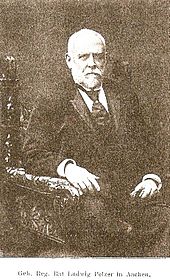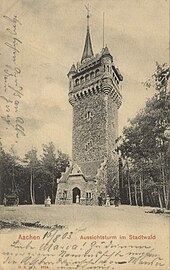Ludwig Pelzer
Ludwig (Matthias Franz Stefan) Pelzer (more rarely also Peltzer ; born June 11, 1835 in Hamm ; † March 1, 1915 in Aachen ) was Lord Mayor of Aachen and a Prussian parliamentarian.
Live and act
The son of the appellate judge Andreas Pelzer (1804-1859) and Bernardine Vuellers (* 1811) as well as nephew of the former mayor of Aachen Arnold Edmund Pelzer and grandson of the municipal counsel Matthias Goswin Pelzer studied law in Berlin, Heidelberg and Bonn and was a founding member of the Catholic Reading Association ( now K.St.V. Askania-Burgundia Berlin ), the first student association of the KV . After taking his state examination in law , Pelzer took up a position as a lawyer in 1862 , first in Cologne at the Court of Appeal and then from 1864 at the Aachen Regional Court. In 1866 he took part in the Austro-Prussian War.
From 1871 to 1873 Pelzer worked for the Kempen constituency, initially as a non-attached member of the German Reichstag and from 1873 as a member of the Erkelenz-Geilenkirchen-Heinsberg constituency for the German Center Party in the Prussian House of Representatives . From 1879 to 1884 he was also a member of the Rhenish Provincial Parliament and the Provincial Administrative Council. Eventually he became a member of the Prussian mansion from 1884 to 1896 . In 1912 he served as honorary president of the German Catholic Congress in Aachen.
Local politics
From 1877 onwards, Pelzer devoted himself increasingly to local politics in Aachen, initially as a city councilor, from 1883 as an alderman and from 1884 to March 1896 as mayor of Aachen.
His outstanding achievements as mayor and mayor in a time of steadily growing population and growing economic power in Aachen included, among other things, a comprehensive reform of the city administration including the purchase or renting of new buildings or rooms for increased administrative needs. He also supported the renewal of the public sewer system for water supply and disposal, the introduction of a comprehensive electricity and gas pipeline system, modern road planning including a rail system for the new tram and, for the first time, the construction of sidewalks separated by curbs. The infrastructural connection to neighboring cities and municipalities as well as to neighboring countries was also taken into account.
He also campaigned for the restoration and renovation of the numerous historical buildings threatened by decay, such as the Aachen town hall itself, the grass house , remains of the old Aachen city wall , towers and gates as well as several churches. During his tenure, he also initiated the construction or expansion of city hospitals, schools, cultural institutions and public baths, as well as the renewal of the city's cemetery, park and recreation facilities, including a sophisticated system of paths and new, attractive excursion destinations in the Aachen forest, including the later to fur tower named him .
His main merit, however, was the preparation of the contract for incorporation with the economically competitive and up-and-coming neighboring town of Burtscheid . After years of tough negotiations, on January 28, 1896, a few months before Pelzer's end of office, the contract for the incorporation of Burtscheid was decided and approved by both the city administration and the royal state government. The resulting law was then signed on December 24, 1896 by Pelzer's successor, Lord Mayor Philipp Veltman and Burtscheid Mayor Karl Middeldorf, and countersigned by King of Prussia Wilhelm II on March 29, 1897.
For his many services, Ludwig Pelzer was awarded the title of a secret councilor in 1893 and, when he left office, the Order of the Red Eagle, 3rd class, with a ribbon. A few weeks after his death, the lookout tower built in the Aachen Forest in 1899 was named Pelzerturm in his honor .
family
Ludwig Pelzer was initially married to Adele Henoumont (1835–1867), with whom he had a son, who died at the age of two. After the sudden death of his wife, he married Therese Maria Franziska Chéruit (* 1850), who gave birth to five girls.
Ludwig Pelzer found his final resting place on Westfriedhof II in Aachen.
Individual evidence
- ^ Mann, Bernhard (edit.): Biographical manual for the Prussian House of Representatives. 1867-1918. Collaboration with Martin Doerry , Cornelia Rauh and Thomas Kühne . Düsseldorf: Droste Verlag, 1988, p. 297 (handbooks on the history of parliamentarism and political parties: vol. 3); for the election results see Thomas Kühne: Handbook of elections to the Prussian House of Representatives 1867–1918. Election results, election alliances and election candidates (= handbooks on the history of parliamentarism and political parties. Volume 6). Droste, Düsseldorf 1994, ISBN 3-7700-5182-3 , pp. 795-797.
literature
- Hermann Friedrich Macco : History and genealogy of the Peltzer families, contributions to the genealogy of Rhenish aristocratic and patrician families , Volume 3, p. 253 ff, Aachen, 1901.
- Hermann Crüger (ed.): Chronicle of the Prussian mansion to commemorate the thirty years of existence of the mansion. Berlin 1885, p. 191
- Hans Joachim Ramm: Family item Peltzer. In: New German Biography (NDB). Volume 20, Duncker & Humblot, Berlin 2001, ISBN 3-428-00201-6 , pp. 168-170 ( digitized version ).
- Festschrift Askania-Burgundia Berlin 1853–2003
Web links
- Ludwig Pelzer in the database of members of the Reichstag
| personal data | |
|---|---|
| SURNAME | Pelzer, Ludwig |
| ALTERNATIVE NAMES | Pelzer, Ludwig Matthias Franz Stefan; Peltzer, Ludwig Matthias Franz Stefan |
| BRIEF DESCRIPTION | German politician (center), Lord Mayor (Aachen), MdR |
| DATE OF BIRTH | June 11, 1835 |
| PLACE OF BIRTH | Hamm |
| DATE OF DEATH | March 1, 1915 |
| Place of death | Aachen |




